Fleurs du Mal Magazine


Or see the index
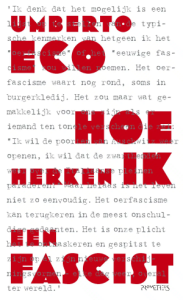 Umberto Eco
Umberto Eco
was een Europeaan
in hart en nieren.
De oorlog in Oekraïne en het steeds verder naar een totalitaire staat afglijdende Rusland zou hij met pijn in het hart hebben aanschouwd.
Maar hij zou waarschijnlijk ook op alle mogelijke manieren van zich hebben laten horen en zich volop hebben ingezet voor vrede.
In Hoe herken ik een fascist, een selectie van drie belangrijke essays, weerklinkt Eco’s immer kritische stem.
Het is een stem waarnaar we moeten luisteren, want sluipend fascisme (‘Het eeuwige fascisme’) en zelfopgelegde censuur (‘Censuur en stilte’) vormen een steeds grotere bedreiging voor de Europese vrede.
Zijn oproep om tot nieuwe Europese afspraken te komen (‘Een nieuw verdrag van Nijmegen’) is dan ook bijna profetisch te noemen.
Umberto Eco (1932-2016) was een van de grootste en succesvolste schrijvers van Europa. Hij werd beroemd met zijn historische roman De naam van de roos, waarna romans volgden als De slinger van Foucault, Het eiland van de vorige dag, De begraafplaats van Praag en Het nulnummer. Ook geldt hij als een van de invloedrijkste essayisten van zijn tijd.
Umberto Eco
Hoe herken ik een fascist
Taal: nl
Paperback
2024
80 pagina’s
Uitgeverij Prometheus
EAN 9789044656794
12,50 EURO
•fleursdumal.nl magazine
More in: - Book News, - Bookstores, Archive E-F, Fascism, Umberto Eco
.jpg)
K ä t h e K o l l w i t z
Die Toten Mahnen uns
Berlin
The street names still reflect old DDR times, before the demolishment of the wall in 1989. The Karl-Liebknecht-Straße runs alongside the Alexanderplatz and connects Prenzlauer Berg to the Museuminsel and Unter den Linden. At the Rosa-Luxembourg-Platz, a few hundred meters to the north, a monument to Herbert Baum and a memorial plaque to Ernst Thälmann commemorate the resistance of the communists against fascism and against the wars that overshadowed life in Europe during the first half of the 20th century. The rise of a working class who lived in miserable conditions dominated social discussions in the early 1900’s. In 1914 a complex combination of imperialism, militarism and strong nationalistic feelings led to the First World War which eventually involved 75 percent of the world’s population and took the lives of 20 million soldiers and civilians. After the war the political situation in Germany remained unstable. The Treaty of Versailles declared Germany responsible for the war, it redefined its territory and Germany was forced to pay enormous war reparations. This treaty caused great bitterness in Germany and was a source of inspiration for both left and right extremism. It eventually led to the rise of fascism and the Second World War. Karl Liebknecht and Rosa Luxembourg, founders of the Kommunistische Partei Deutschland (KPD), were killed in 1919 by Freikorpsen, right extremist remainders of the German army. Herbert Baum and his resistance group were killed by the Gestapo in 1942 and Ernst Thälmann, Hitlers political opponent during the elections of 1932, was executed in Buchenwald in August 1944, on direct orders from Hitler.
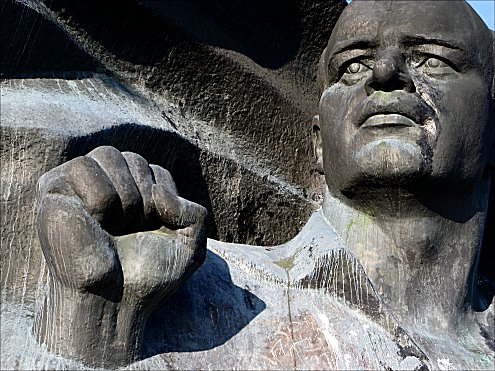
Käthe Kollwitz
Käthe Schmidt was born in Königsberg in 1867 in a family of social democrats that were sensitive to the changes that were taking place in society. Her talent for art was recognised and stimulated by her father. She received lessons in drawing in a private art school in Berlin. Under the influence of her teacher Stauffer-Bern and the work of Max Klinger she decided to focus on black and white drawing, etching and lithography. She married Karl Kollwitz, a friend of the family, in 1891. Karl had decided to dedicate his live to the poor working class and started a doctor’s practice in Prenzlauer Berg in a street that is now called the Käthe-Kollwitz-Straße. They had 2 sons, Hans and Peter. Käthe was deeply moved by the social misery she was confronted with in her husbands practice and the life of the working class became a dominant theme in her work. It was Gerhard Hauptman’s play ‘die Weber’ that inspired her to her first successful series of etchings called ‘Ein Weberaufstand’. Another successful series was ‘Bauernkrieg” for which she received the prestigious ‘Villa Romana’ price. At the age of 50 Käthe had become famous throughout Germany and to the occasion of her birthday, exhibitions of her work were held in Berlin, Bremen and Königsberg.
In October 1914 her son Peter was killed in the trenches of Flanders. To his memory Käthe designed a monument which took her almost 18 years to complete. In Diksmuide-Vladslo, in a landscape covered by hundreds of war cemeteries, her ‘Grieving Parents’ impressively expresses the poignant grief and helplessness of parents who have lost a child. The death of her son had a great impact on her work and war and death became the dominant themes. When Karl Liebknecht was killed in 1919 his family asked Käthe to make a drawing to his memory. In a charcoal drawing she depicts the worker’s farewell to Liebknecht. A final version in woodcut was made 2 years later. Sieben Holzschitte zur Krieg were made in 1920/1923 and her famous poster Nie Wieder Krieg, a consignment by the International Labours Union, in 1924. She was not the only artist that stood up against war but while the artistic protests of for instance George Grosz, Otto Dix or Frans Masereel were primarily aimed at the horrors of the battlefield or the political climate, Käthe Kollwitz’s concern was with the human suffering of those who were left behind.
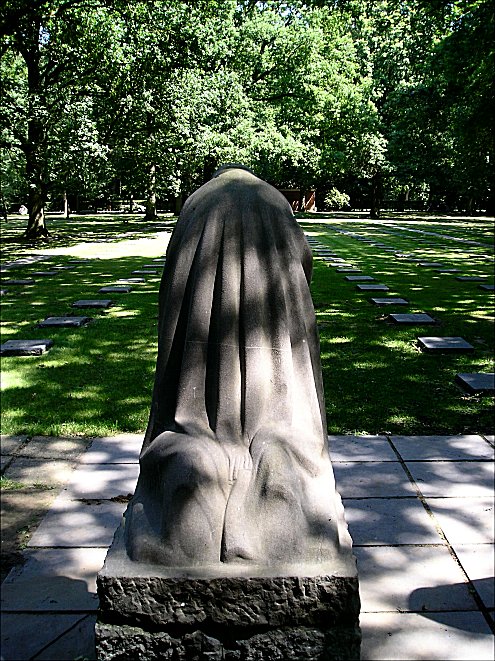
When the Nazis came to power in 1933, she and her husband signed an urgent appeal to unite the working class and to the formation of a front against Hitler. The SPD and KPD were forbidden by the Nazis and Käthe was removed from her position at the Berlin Art Academy where she was heading the Masterclass of Graphics. Exhibitions of her work were forbidden. Karl was also temporarily disallowed to exercise his practice and their financial situation became precarious until his ban was relieved due to a shortage of skilled physicians. Karl Kollwitz, after a life dedicated to the health of the poor, died in July 1940.
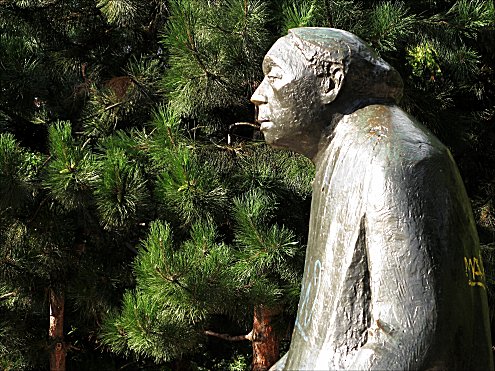
After Karl’s death Käthe suffered from depression and her physical condition was rapidly declining. The house in Berlin where she and Karl had been living since 1891 was bombed in 1943 and Käthe was evacuated to Nordhausen and later to Moritzburg. A few days before the end of the Second World War, in April 1945, Käthe Kollwitz died. She was buried in the family grave in Berlin-Friedrichsfelde at the same cemetery where a memorial monument pays tribute to the socialist heroes Karl Liebknecht, Rosa Luxembourg and Ernst Thälmann.
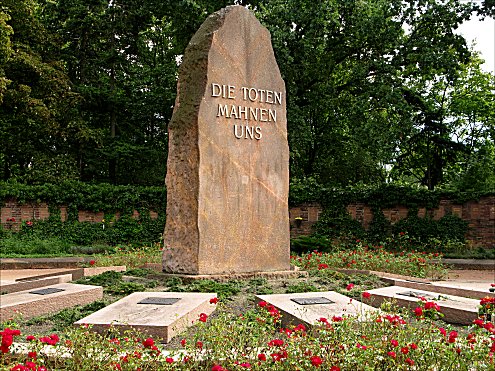
A mission
Käthe’s importance as an artist cannot be overvalued. Her authentic, expressive depictions of human misery, resulting from the exploitation of human labour, from fascism and war, are timeless, genuine and moving. She was not a politician but an artist with a vocation who found a way to make art that goes straight to the heart.
When you are in Berlin be sure to visit ‘Die Neue Wache’, a building designed by Christian Schinkel, which since the 1960-s is a monument against war and fascism. In the centre of the building, right beneath a circular opening in the ceiling, Käthe Kollwitz’s sculpture Mother and Child is an arresting plea for vigilance against mentalities and attitudes that may again lead to fascism and war.
References:
Ilse Kleberger: Kathe Kollwitz, Eine Biographie
Venues
Neue Wache – Unter den Linden near the Museuminsel
Kathe Kollwitzmuseum Berlin – Fasanenstrasse 24
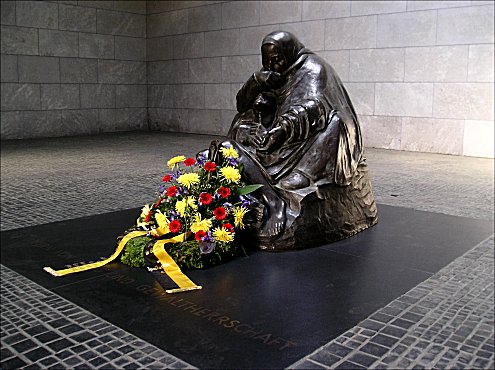
Käthe Kollwitz: Die Toten mahnen uns – part I
Photos & text: Anton K. Berlin
![]()
Find also on fleursdumal.nl magazine:
Nie Wieder: Wache gegen Faschismus
and
Historia Belgica: Alles voor Vlaanderen
![]()
fleursdumal.nl magazine – magazine for art & literature
to be continued
More in: *War Poetry Archive, Anton K. Photos & Observations, Fascism, Käthe Kollwitz, Sculpture
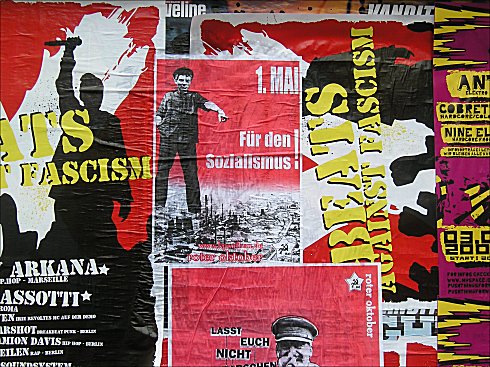
Street poetry: Against fascism
photo Anton K. Berlin – fleursdumal.nl magazine
More in: Anton K. Photos & Observations, Fascism, MUSEUM OF PUBLIC PROTEST, Street Art
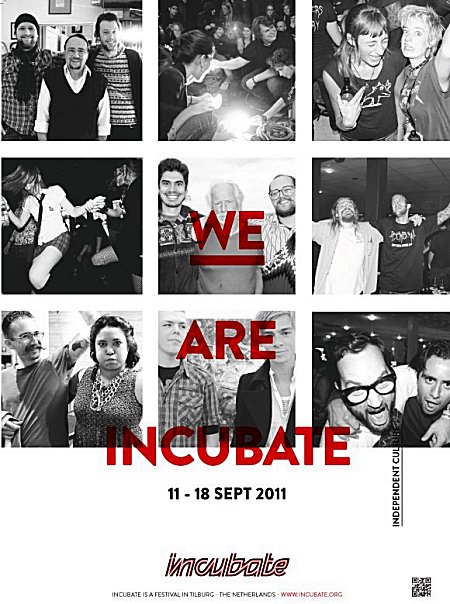
Rob Riemen op Incubate
in gesprek over
fascisme
Essayist Rob Riemen zal op zaterdag 17 september tijdens het Incubate festival in gesprek gaan met schrijver Joost de Vries. Het gesprek wordt een vervolg op de lezing die Riemen gaf op het Lowlands festival in augustus, en de discussies die daarop volgden.
Rob Riemen (1962) is essayist en oprichter-directeur van het internationaal gerenommeerde en in Tilburg gevestigde Nexus Instituut. In De eeuwige terugkeer van het fascisme schetst Rob Riemen de cultuurgeschiedenis van het fascisme, en houdt de huidige Nederlandse samenleving daarmee een spiegel voor. Het hedendaags fascisme moet namelijk niet vergeleken worden met waar het twintigste-eeuwse fascisme op is uitgelopen, maar met hoe het begon.
Op het Lowlands festival hield Riemen de lezing Waarom zijn we vergeten wat belangrijk is in het leven? over onder meer het fascisme. Hij sloot zijn betoog af met een verwijzing naar Wilders die de generaal is van een groeiend leger aan domme krachten: “De strijd tegen het fascisme begint met de strijd tegen de domheid… in onszelf! Durf te denken, durf kritisch te zijn en koester de kunsten. Verzet je tegen al wat dom is en wees dapper.”
Na afloop van de Lowlands lezing vond een publiek debat plaats binnen diverse media. Wat is de cultuurgeschiedenis van het fascisme en van deze politiek? Moet een culturele organisatie zich engageren? Wat is de rol die intellectuelen en media innemen in deze discussie? In een gesprek met De Groene Amsterdammer redacteur en schrijver Joost de Vries zal Rob Riemen op het Incubate festival dieper op deze thema’s ingaan. De titel van het gesprek luidt Why Deny Fascism?
Het Tilburgse Incubate festival kiest er bewust voor om dit thema uit te lichten. “Dit jaar hebben we als thema We Are Incubate. Dat gaat over nieuwe vormen van samenwerking binnen de culturele sector. “Maar als je open bent, mag je ook wijzen op de gevolgen van uitsluiting,” aldus Joost Heijthuijsen, directielid van Incubate. “Openheid is vertrouwen en creativiteit. Geslotenheid leidt tot angst.” Ook sluit het thema goed aan bij het engagement van de optredende artiesten. Bezoekers van het festival kunnen op dezelfde dag onder andere nog naar een door Steve Ignorant, zanger en spreekbuis van legendarische anti fascistische punkband Crass, samengesteld programma gaan kijken.
Why Deny Fascism?
Rob Riemen in gesprek met Joost de Vries
Zaterdag 17 sept. van 14:00 tot 15:00 uur
Theaters Tilburg, Audaxzaal
Gratis toegang
Dit gesprek vindt plaats tijdens Incubate, een festival voor independent culture. Het heeft een breed programma met veel muziek, beeldende kunst, debat, film en hedendaagse dans. Gedreven door artistieke vernieuwing brengt Incubate meer dan 200 culturele voorlopers. Zij presenteren zich in een intieme context aan een internationaal publiek. Black metal naast free folk. Verfrissende kunst naast inspirerend debat.
Incubate 2011 is op 12 tot en met 18 september. Zie voor meer informatie kijk op de website www.incubate.org
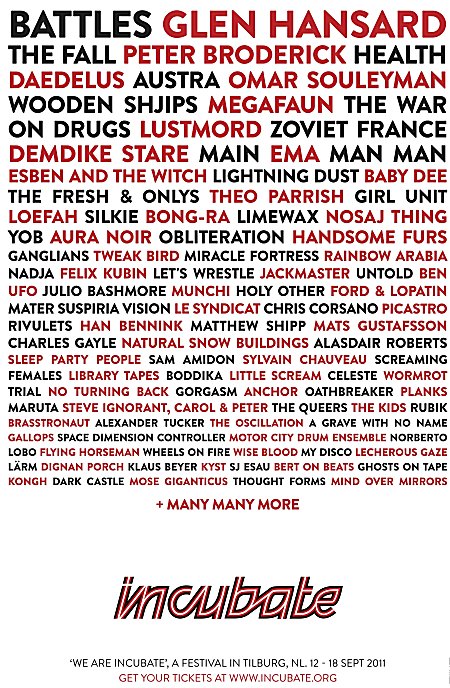
fleursdumal.nl magazine
More in: Art & Literature News, Fascism, LITERARY MAGAZINES, Nexus Instituut, The talk of the town
Rob Riemen
De eeuwige terugkeer van het fascisme
In De eeuwige terugkeer van het fascisme schetst Rob Riemen de cultuurgeschiedenis van het fascisme, en houdt de huidige Nederlandse samenleving daarmee een spiegel voor. Het hedendaags fascisme moet namelijk niet vergeleken worden met waar het twintigste-eeuwse fascisme op is uitgelopen, maar met hoe het begon.
Riemen betoogt dat dit fenomeen niets anders is dan de logische politieke consequentie van een maatschappij waar wij allen verantwoordelijk voor zijn – ‘… het gevolg van politieke partijen die hun eigen gedachtegoed verloochenen, intellectuelen die een gemakzuchtig nihilisme cultiveren, universiteiten die deze naam niet waardig zijn, de geldzucht van de zakenwereld en de massamedia die liever de buikspreker van dan een kritische spiegel voor het volk zijn. Dit zijn de gecorrumpeerde elites die de geestelijke leegte cultiveren waarin het fascisme weer groot kan worden.’
Het hedendaags fascisme moet niet vergeleken worden met waar het twintigste-eeuwse fascisme op is uitgelopen, maar met hoe het begon. In De eeuwige terugkeer van het fascisme schetst Rob Riemen de cultuurgeschiedenis van die politiek en concludeert hij dat Geert Wilders en zijn beweging een logisch gevolg zijn van een nihilistische massamaatschappij waar wij allen verantwoordelijk voor zijn.
‘Geert Wilders en zijn beweging zijn het prototype van hedendaags fascisme. En daarmee zijn zij niets anders dan de logische politieke consequentie van een maatschappij waar wij allen verantwoordelijk voor zijn. Dit hedendaags fascisme is opnieuw het gevolg van politieke partijen die hun eigen gedachtegoed verloochenen, intellectuelen die een gemakzuchtig nihilisme cultiveren, universiteiten die deze naam niet waardig zijn, de geldzucht van de zakenwereld en de massa media die liever de buikspreker van dan een kritische spiegel voor het volk zijn. Dit zijn de gecorrumpeerde elites die de geestelijke leegte cultiveren waarin het fascisme weer groot kan worden.’
Uitgeverij Atlas
ISBN: 978 90 4501 8560
pagina’s: 64
prijs: € 9,95
fleursdumal.nl magazine
More in: Fascism, Nexus Instituut, REPRESSION OF WRITERS, JOURNALISTS & ARTISTS, The talk of the town
.jpg)
VERZETSMUSEUM AMSTERDAM
Protesteer!
Actieposters vanaf 1965
16 oktober 2008 – 29 maart 2009
Baas in eigen buik
Dodewaard gaat dicht
Help de kernwapens de wereld uit
Geef fascisme geen kans
Kernernergie? Nee bedankt
Shell helpt apartheidterreur
Geen woning geen kroning
Protesteer! is een tentoonstelling met posters
over spraakmakende maatschappelijke kwesties
De thema’s zijn:
– Oorlog en Vrede
– Emancipatie
– Antiracisme en Antifascisme
– Kraken en Wonen
– Milieu en Dieren
– Internationale solidariteit
– Tweede Wereldoorlog
.jpg)
fleursdumal.nl magazine
new website: www.antonykok.nl
More in: Apartheid, Fascism, Feminism, MUSEUM OF PUBLIC PROTEST, Pax for peace, Racism, Street Art
Thank you for reading Fleurs du Mal - magazine for art & literature